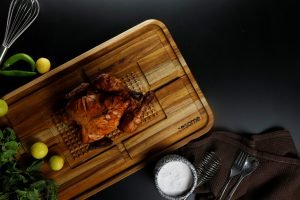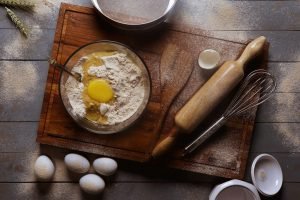
How to clean and care for your wooden boards
[vc_row][vc_column][vc_column_text] First things first, should

One of the easiest things you can do to make your cooking easier is buy a good cutting board.
A cutting board can either be your knife’s best friend or worst foe. The good one is useful and harmless, the bad one might seem equally useful but is secretly contaminating your food.
The battle between wood, plastic and bamboo has been fought over and over again. Which is the most sanitary? Which one is the easiest to clean? Which one is hygienic? This article is going to answer all that.
But the biggest mistake you can do is let someone else do your thinking for you – especially a sponsored culinary magazine.
We’re going to state facts and you are going to decide whose side are you on – plastic, bamboo or wood?
There has been many studies done on the bacteria manifestation in plastic cutting boards, their effects on knives and tests of their sanitation.
And the result?
Sanitary
As you can guess, plastic has earned a bad reputation when it’s come to health. Earlier thought to be the most sanitary, recent studies have proven that hardwood is actually more sanitary as compared to plastic.
This is because when a plastic board has taken many knife cuts, it gets difficult to disinfect without using harsh chemicals. And these knife scars actually give a room for bacteria to grow.
In fact, one study has found that those who used plastic cutting boards double their chances to contract salmonella.
So, hygiene and plastic don’t get along well. What about maintenance though?
Maintenance
Plastic boards were considered the easiest to maintain because you can slide them over to the dishwasher. And it was also thought that they can be more aggressively cleaned than their counterparts by dousing them with bleach.
And that sounds dreamy, to just run a board through the dishwasher without any worries. But as we have seen in sanitation, the knife scars give room for bacteria to grow – so you’re not really cleaning those germs.
And it’s impossible to disinfect a plastic board manually after a knife scar has made its mark and let bacteria in. The only way is to chuck it away.
Talking so much about knife scars, you might have guessed that there is no visual maintenance in a plastic cutting board – the knife scars are ugly and the shape loosens eventually.
Knife scars are ugly. But do knives remain the same after using them on plastic?
Knives
Many researches have time and again proven that plastic dulls your favorite knives. Plastic boards lose their look and the knife loses its sharpness – it’s a two-way street.
Knives ruin your plastic board and your plastic board ruins your knives. They’re enemies.
What about the environment?
This one is a no-brainer. Plastic has a huge donation in damaging the environment. It might be cost effective for you, but it costs a lot to the environment.
Conclusion
If you are willing to buy a chopping board every few months, and knives, along with doing your part in damaging the environment and your own health – buy a plastic board.
Now, let’s hop over to the choice of the environmentalists.
Bamboo is the environment friendly choice. But how good does that translate for your kitchen?
Sanitary
Bamboo is considered equal to wood when it comes to sanitation. Some studies actually show that they absorb more liquids than wooden boards.
And growing bamboo doesn’t require any chemicals, so no harmful bacteria go in growing them.
But, it’s not all goody-good. Bamboo is actually pretty cheap and fast to grow, so everyone is trying to gain a few bucks – this puts the original composition of the bamboo in question.
Plus, you got to check for formaldehyde-based glues often used in bamboo boards to hold them together. If you don’t know what formaldehyde is – it’s a chemical compound correlated with causing cancer.
Bottom line, you got to be careful where you buy your bamboo board from. But even the good ones require maintenance.
Maintenance
Similar to hardwood, it requires oiling from time to time. And unlike plastic, damaged bamboo surfaces can actually be restored through mineral oils.
If you use your bamboo cutting board for chopping meat, you have to disinfect them after every use to avoid contamination.
Also, in bamboo boards, it’s easier to spot a vegetable stain and an odor. To clean the vegetable stain, scrub coarse salt on the board with a sponge, rinse and dry. To get rid of a stinky odor, rub a paste of baking soda and water, rinse and dry.
Now, let’s move on to the most depressing part about bamboo.
Knives
Bamboo is 19% hard than your traditional maple. This means much more harder on your knives – which as you can guess, cuts your knife’s life with every chop.
They also have small grooves that might interrupt a smooth chopping and sadden your knives.
But a bamboo board sure does love the environment.
What about the environment?
You know it’s the most environment friendly choice. But let me just tell you why.
Bamboo is a fast-growing grass. During harvesting, it’s first carefully chosen for maturation, size and markings. Then, the resulting stalk is divided into definite sizes. Then, pressing begins to divide into further smaller, board-like-looking pieces.
And a bonus is that they do not require any chemicals or pesticides to thrive when they are harvested.
Conclusion
If you want something good for the environment but bad for your knives, bamboo board is the way to go. But avoid using boards glued together using formaldehyde-based glues.
Now, let us chop some wood.
Wood has had an on-again off-again relationship with culinary magazines and kitchen articles that tell you which material board to buy.
Till now, tremendous amounts of research has been done on wooden cutting boards and here are the results:
Sanitary
Wooden cutting boards may not be as easy to clean as plastic cutting boards, but they sure are a way healthier choice.
A wooden cutting board does not retain bacteria or knife scars. Wood actually possess antiseptic properties and is a highly renewable resource after bamboo.
But, as with bamboo, check out for formaldehyde-based glues being used along with poisonous polishes used for making wooden boards shine.
All good things require work, and timely maintenance.
Maintenance
You can clean wooden boards with warm, soapy water and a sanitizer. It can also be cleaned in an all-natural way, click here to see how.
And visually, wood boards steal the show. They don’t require any visual maintenance too, because they are self-healing – the fibers making up the wood stick back together – and shallow knife cuts close up on their own.
But, what’s the relationship between wooden boards and knives?
Knives
Wooden boards loves your favorite knives as much as you love them. No kidding. They keep knives sharper for longer – especially a softwood board.
So knives and wooden boards have a loving friendship.
What about the environment?
Wooden boards that are made by chopping trees down from the forest clearly harm the environment and disturb its ecological cycle.
But a wooden board that is made from leftover wood of the mills or from harvested plantations leave the forests unaffected.
So, whether or not you’re damaging the environment depends on where you buy your wooden board from.
Conclusion
Wooden boards are your knife’s best friend, hygienic, require little to no maintenance with no damage to the nature if you buy it from the right source.
Now that you’ve read and understood all the factual details of plastic, bamboo and wooden boards, it won’t be hard for you to solve the conundrum in your kitchen’s favor.

[vc_row][vc_column][vc_column_text] First things first, should

[vc_row][vc_column][vc_column_text]Have you ever seen a

When looking at cutting boards,

[vc_row][vc_column][vc_column_text]“Ugh. Another marketing gimmick about

